
In the article “Watermarked Paper First Series”, published in Pattaya Mail on Friday February 12, 2021, I wrote about problems with the watermarked paper. His Excellence Phya Suriyanuwatr, Minister of Finance, complained that the watermark was more and more indistinct. As a consequence, close to 100,000 banknotes of 10 Baht denomination were to be returned to the printer Thomas de la Rue & Company Limited London (TdlR) and replaced. For security reasons the 10 Baht banknotes with indistinct watermarks were burned in Thailand. A new watermark was produced; the Thai and English denominations were done in a single outline. Earlier the denominations were made in double outline.
During the 23 years, 1902-1925, TdlR produced the artwork and printed the banknotes, First Series for Siam. Most of the time this worked very well, but from time to time some problems occurred. This had to do with the distance and communication between Bangkok and London.
The letters and numbers on the artwork were mostly done in Thai. Therefore, the engravers of the plates had a difficult task, as they were not too familiar with the Thai numbers and alphabet. On the 10th of June 1907 a change took place. Instead of sending artwork and banknotes for approval from London to Bangkok, which at the time took about one month, it was the intention of His Siamese Majesty’s Government that in most cases the inspection and approval should take place in London.
At that time His Excellency Phya Visutr Kosa was the Minister at the Siamese Consulate in London. The Minister had, during the years questioned, made corrections concerning the production of banknotes and considered to be valuable assistance for TdlR. Another recurring problem was that while the banknotes were urgently needed in Thailand there were delays with the production in London. There were also delays with the shipments of the banknotes from London to Bangkok.
When the School of Oriental Studies was founded in 1916, they assisted TdlR with Siamese letters and numbers several times which helped speed up production significantly.
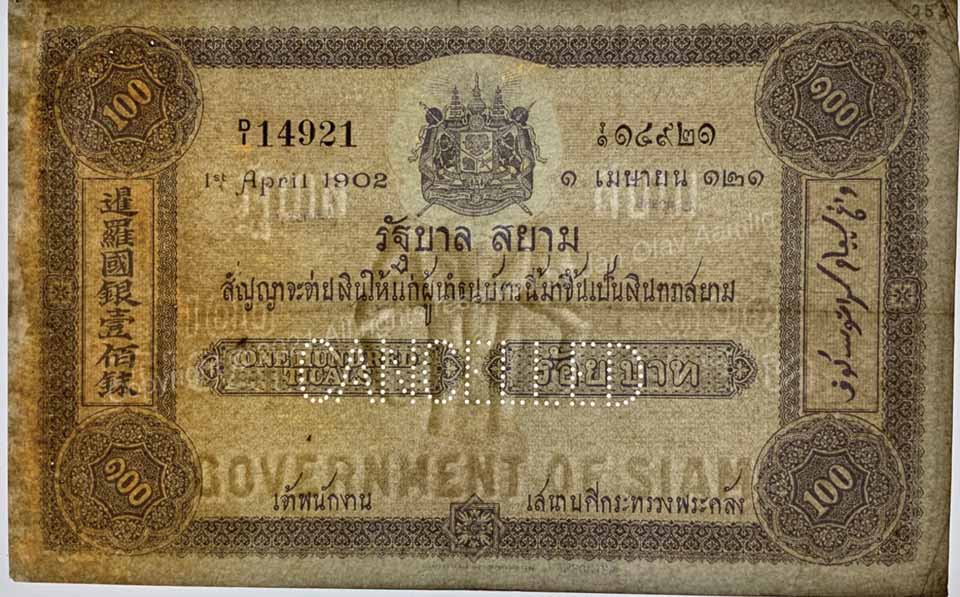

TdlR informed the Siamese Minister in London in a letter dated 22nd February 1909 that a small portion of the 100 Tical/Baht notes dated 1st of January 1909 would be printed on the old watermarked paper. This was not a problem as TdlR had informed the Minister of Finance that they had a stock of the old paper which had to be used up. This should be of interest for collectors who would like to have the 100 Baht dated 1st of January 1909 printed on both old and new paper.
This could have been the case for other values as TdlR had a stock of the old, original watermarked paper as of 22nd September 1909. They included approximately 90,000 pieces for 5 Ticals, about 12,000 pcs for 10 Ticals, about 16,000 pcs for 20 Ticals, about 2,000 for 100 Ticals and about 9,000 pcs for 1,000 Ticals.


Charles James Rivett Carnac, Financial Agent for His Siamese Majesty’s Government, sent a letter to TdlR on the 4th of June 1909 regarding a 100 Tical/Baht banknote which was approved in August 1906. The banknotes had been sent out in April of the previous year and were not in the shades and colour of the approved specimens. The impressions of the notes were “smudgy”. The approved specimen was much better in clearness of definition and general finish. TdlR replied on the 7th of June that the specimen notes were printed on thick proof paper, and of course when printed on thin watermarked hand-made paper the effect was not quite as clear. The same ink was used and the difference in appearance was solely due to one being printed on a hand-made paper and the other on proof paper.
On the 9th of June, Rivett Carnac replied that for later printed notes of the denominations appeared to be more distinct and clearly cut impressions. TdlR replied on the 10th of June that the reason for the difference in appearance is that the 100 Tical/Baht banknote approved in August 1906 was printed on a somewhat thicker paper. A new thinner paper was approved on 24th September 1908.
It was agreed that specimens submitted for approval should be printed on watermarked paper, the same paper that would be used for printing the notes intended for circulation. Of course TdlR would perforate the specimen notes for approval with “CANCELLED”.
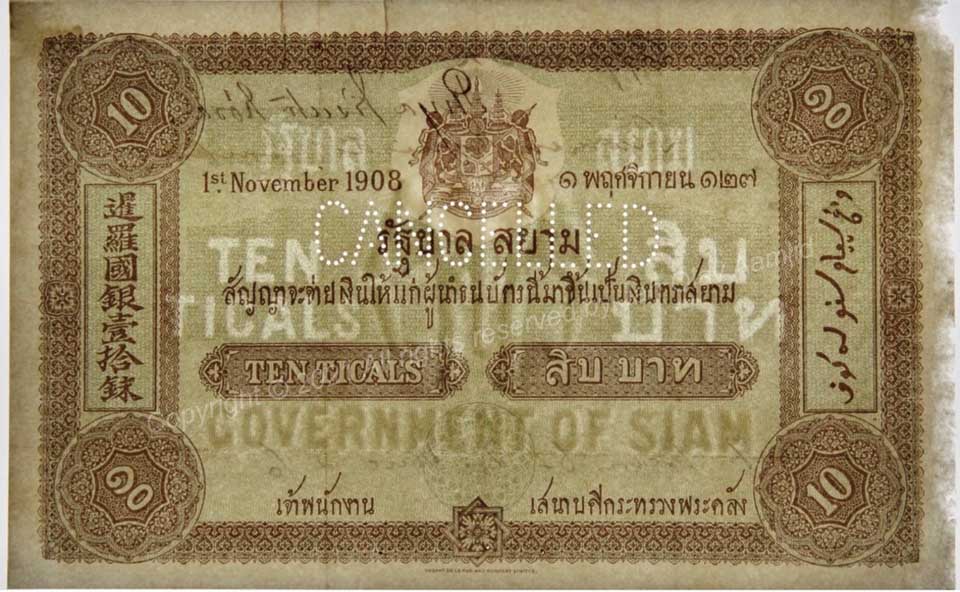

His Excellency Phya Visutr Kosa, Siamese Minister to the United Kingdom, pointed out in a letter of the 16th of December 1909, that on the 10- and 20 Tical/Baht specimen watermarked paper he had received on the 10th of September the watermark and lettering were not in exactly same position. The difference, though slight, is apparent if the specimen watermarked papers were placed one above the other and held up to the light. TdlR replied to the Minister on the 17th of September that the paper was made from the same moulds. The paper was hand made, and as such, there is always the slight variation in the watermark. The slight difference was also caused owing to the couching and partly to the contraction in drying. It was utterly impossible to avoid it.
Mr W.J.F. Williamson, British officer, Ministry of Finance of India, had been working with the project to produce banknotes for Siam and became a Financial Advisor. During an interview with TdlR on the 22nd of September 1910, it was discussed whether the Siamese Government could supply their own watermarked paper and TdlR would do the printing. The reason for this discussion was probably because of the recurring discussions about watermarked paper.
TdlR agreed with this in a letter of 24th September provided the watermarked paper was of suitable quality and ready for printing. In the letter TdlR quoted prices for doing the printing on watermarked paper supplied by the Siamese Government. Mr Williamson replied to the letter of 21st April 1911 that the authorities had decided this would not take place before issuing notes of a new design. He also feared that this would take considerable time to prepare and obtain proofs of the new notes. In the meantime the old arrangement would continue.
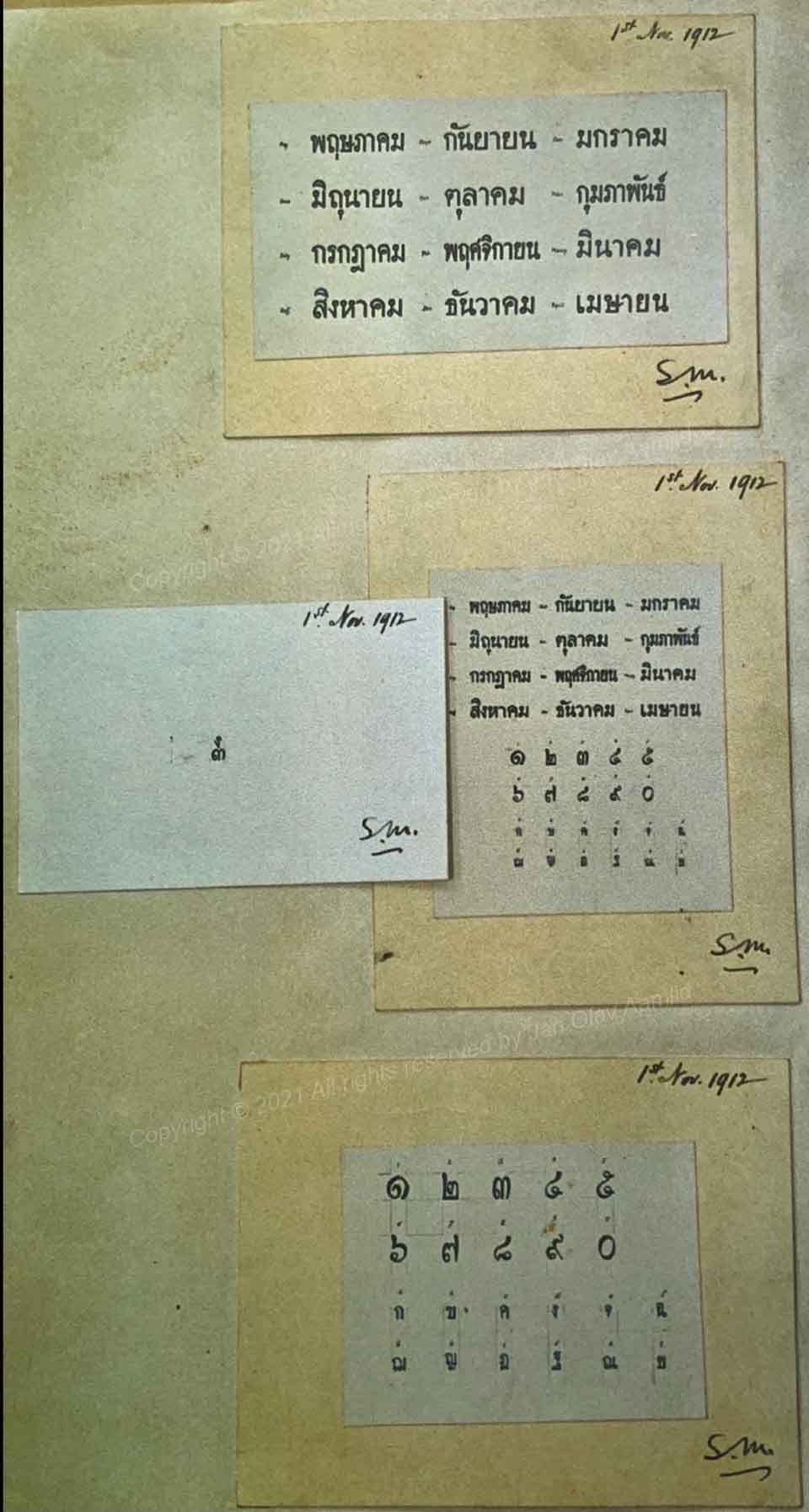
On the 27th of September 1912, Mr W.J.F Williamson informed TdlR that he had received a wire from the Minister of Finance, Bangkok, that there was a spelling mistake in the Siamese month on the 10 Tical /Baht note with the prefix B/10 dated 1st June 1911. TdlR wrote that they regretted the mistake in a letter of October 1st 1912.
Nevertheless TdlR found that the agreed engraving with the design was submitted to the Siamese Legation in London and was approved by the Secretary on October 21st 1901.
After some exchanges of letters discussing the mistake, it was established that specimen notes of the 10 Tical Baht dated 1st June 1911 had not been sent for approval. Phya Sudham Maitri, Siamese Minister in London, said in a letter of 19th of October, “Had this precaution been taken, the mistake would doubtless been detected before the notes were sent to Bangkok.”
TdlR was of the opinion that in 1907 it was agreed that specimen paper was to be sent of each value in the first instance; that is to say when new paper was delivered from the paper maker. The dates for the banknotes were changed at each 100,000, and to avoid such an error in the future, TdlR suggested in the future that they would submit impressions of all changes in the date for the whole of the order. The Siamese Minister in London would get a complete check on the whole work to be carried out, before the printing commenced.
The Siamese Minister in a letter of 25th October agreed to this arrangement and TdlR would continue to submit for approval specimens of the first batch of notes printed on each indent. For the future the prefixes and series numbers would also to be approved.

The Comptroller General in Bangkok, Prince Bidyalongkorn, informed TdlR on the 30th June 1915 that on the 20 Tical/Baht banknote with the series number C/9 dated 28th October 1914, 47 notes did not have the serial number which was supposed to be printed on the right hand bottom corner. The numbers of the notes were 42301 to 42347. The Comptroller General asked TdlR to deduct the cost of 3 shilling and 6 pence from the next bill for these defective notes. TdlR expressed their regret of the error made by their examiners in passing the notes.

On the 18th of September 1915, TdlR informed the Director of Paper Currency in Bangkok that one 5 Tical/Baht banknote was lost. The banknotes were shipped per S.S. “Atsuta Maru” on the 23rd of June 1914. TdlR had printed 105,300 of the banknotes under strict scrutiny. 100,000 banknotes were invoiced, 3 specimens were sent to the Siamese Legation in London, 5,296 were waste and destroyed, but one was not accounted for.
TdlR offered to credit the Paper Currency Department in Bangkok with the face value of 7 shillings 6 pence. On the 9th of May 1916 the Comptroller General, Chaiyos Sombat informed TdlR that one of the packets recently opened was found to contain 101 notes. Two of them bore the same number A/10 44252. The Comptroller General said it was not necessity to credit their account. TdlR was pleased to be informed that there was no shortage. They regretted to hear that one of the numbers was duplicated. TdlR would make enquires into the cause with a view to avoiding the recurrence. For collectors two banknotes with the same number would be interesting and rare.

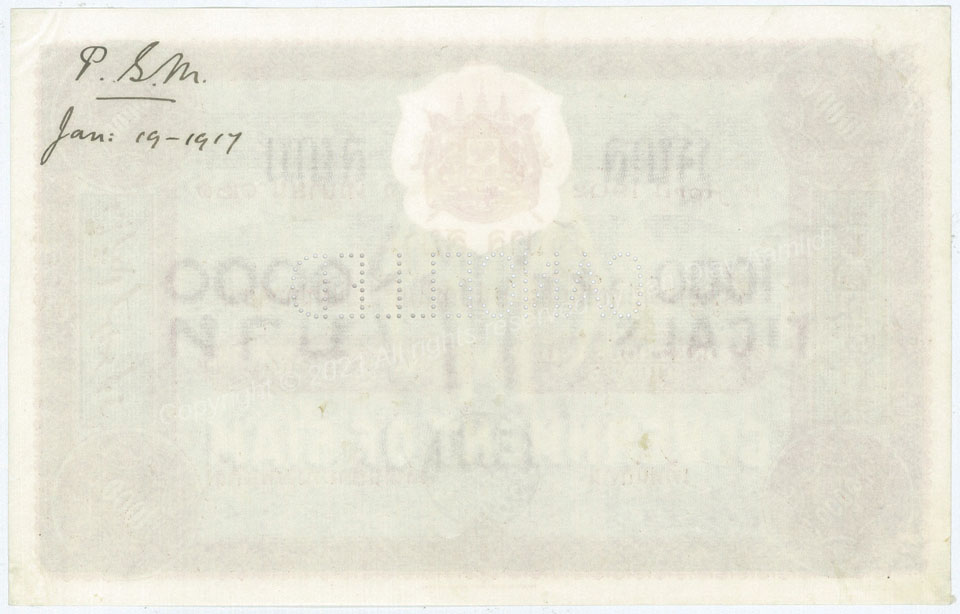
The Minister of Finance ordered 10,000 of the 1000 Tical/Baht banknotes from TdlR on the 9th of March 1916. TdlR informed the Siamese Minister in London that they would be dating the 1000 Tical/Baht 1st April 1902 and use the Siamese year RS121, not the Buddhist Era as TdlR had been instructed in 1913. The Siamese Minister in London wanted TdlR to explain why the new notes should bear the old date as a new era had been adopted in Siam.
In 1901 the Director of Paper Currency Department had instructed TdlR to only change the date when the number of notes had reached 99,999, or whatever the maximum was. The new print of 1000 Tical/Baht notes was to be numbered E/1 30,000 till E/1 40,000. The new print of 1000 Tical/Baht note was initialled as approved by Phya Sudham Maitri on 19th January 2017. Those banknotes, as well as the 89,000 printed 1000 Tical/Baht banknotes were all dated 1st April 1902.

In a memorandum dated August 15, 1917, the Siamese Minister of Finance, H.R.H. Prince Kitiyakara complained about the texture of the paper and the colours of the printing on a large majority of the supply of 50,000 notes of the Ticals 100 denomination, Series D/4 recently supplied. The Minister of Finance requested that this fault must be prevented in the future, as a repetition of such differences would seriously affect the popularity of the notes. Phya Sudham Maitri, the Minister in London, informed TdlR about the memorandum in a letter dated October 23, 1917.
A couple of days later, TdlR informed the Siamese Minister in London that these banknotes were printed on handmade paper and that it was impossible to obtain absolute uniformity in substance on this high class paper. Nevertheless, TdlR would request the mill to pay special attention to this matter and to keep the paper as uniform as possible. Regarding the variation of colour, TdlR informed the Siamese Minister that they were experiencing considerable difficulty in obtaining suitable inks since the commencement of the war. The difference in colour may be due to this trouble.

Millbourn & Company Limited of Tuckenhay Mills produced handmade watermarked banknote paper for TdlR. The paper from Tuckenhay Mills was used for the printing of Siamese banknotes amongst many other clients. On April 4, 1918 TdlR sent a letter to the Siamese Minister in London informing them that the paper maker had asked TdlR to approach the Siamese Minister in London to request them to write a letter stating that certain skilled workers were absolutely essential for the production of the paper for Siamese banknotes. The letter should be submitted to the Tribunals so that those skilled men would be exempted from military service.
On April 17th TdlR sent another letter asking for a letter for the paper maker as the Tribune were meeting in a few days. If the skilled workers had to do military service, the shortage of manpower would delay the urgently needed 1 Tical/Baht banknotes.

The Siamese Minister in London replied on April 18th that he regretted that he could not write such a letter as they were not directly employed by him and serving in the military was required for all British subjects. It was impossible for the Minister to interfere with the laws of the British Government. On the 22nd of April TdlR informed the Siamese Minister that 700,000 pieces of the 1 Tical/Baht banknotes had been shipped and that another 250,000 pieces were ready for shipment.
Owing to the war, there was a shortage of material and increased costs of labour and the cost of all papers had increased to an enormous extent. Under these exceptional circumstances, TdlR had to increase the cost of the notes by 15% as a temporary measure. The Siamese Minister in London responded in his reply that the increased price was only to continue for the duration of the war. In 1918 the consequences of the war led to delays in deliveries of banknotes. The Spanish Flu Pandemic of 1918 affected several TdlR staff. This contagion also led to delays of deliveries of banknotes to Siam.
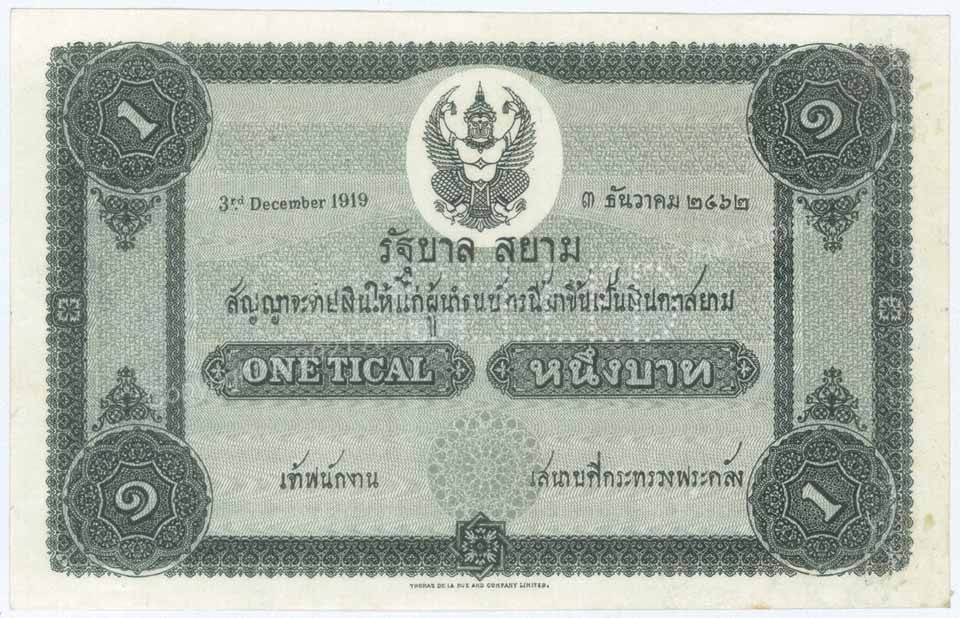
On January 30th 1919, the Siamese Minister in London, Phya Sudham Maitri, informed TdlR that 1 Tical/Baht banknotes were urgently needed. The Siamese Minister of Finance, H.R.H. Prince Kitiyakara wished to know when TdlR could supply 10 million 1 Tical/Baht banknotes. If TdlR could not supply the banknotes, His Royal Highness would regrettably be compelled to place the order elsewhere. TdlR replied that they could deliver 100,000 banknotes in four weeks, 150,000 in five weeks and continue to deliver 250,000 notes per week. This was accepted and the serial number would be Y.

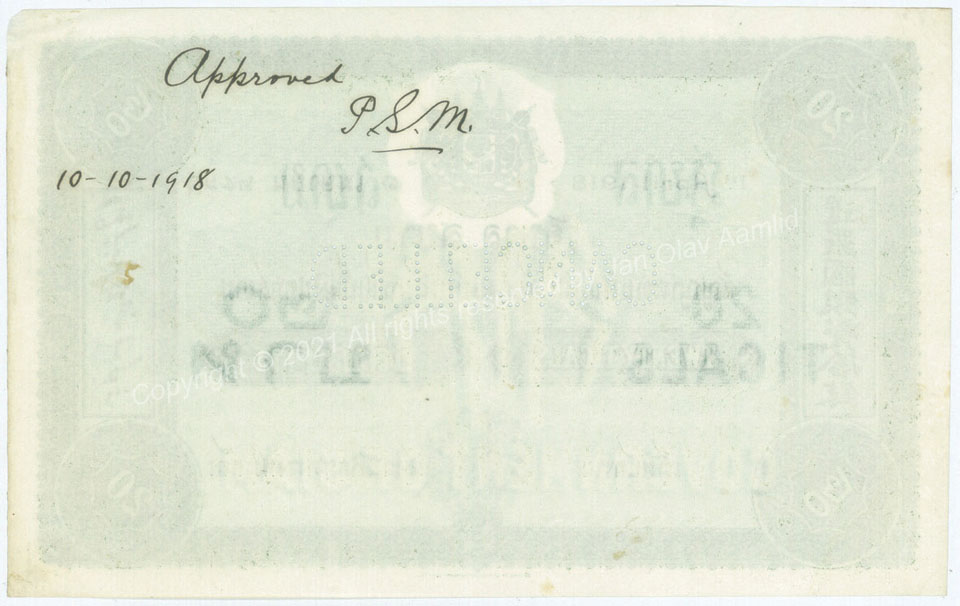
TdlR shipped 100,000 20 Tical/Baht banknotes per S.S. “Benrinnes” of Messer’s Killik, Martins line that sailed on January 15, 1919. The Ministry of Finance had been informed that the S.S. “Benrinnes” would not reach Singapore until March 16. The Ministry of Finance desired that no more notes were to be despatched by slow cargo boats that took up to two months to sail from England to Singapore. The Ministry had been informed that Holt’s Line from Liverpool had a fast and regular service to Singapore. In the future TdlR would utilize the Holt line from Liverpool and hoped it would avoid delays in the future. The ships of Holt Line were supposedly able to sail from Liverpool to Singapore in one month.
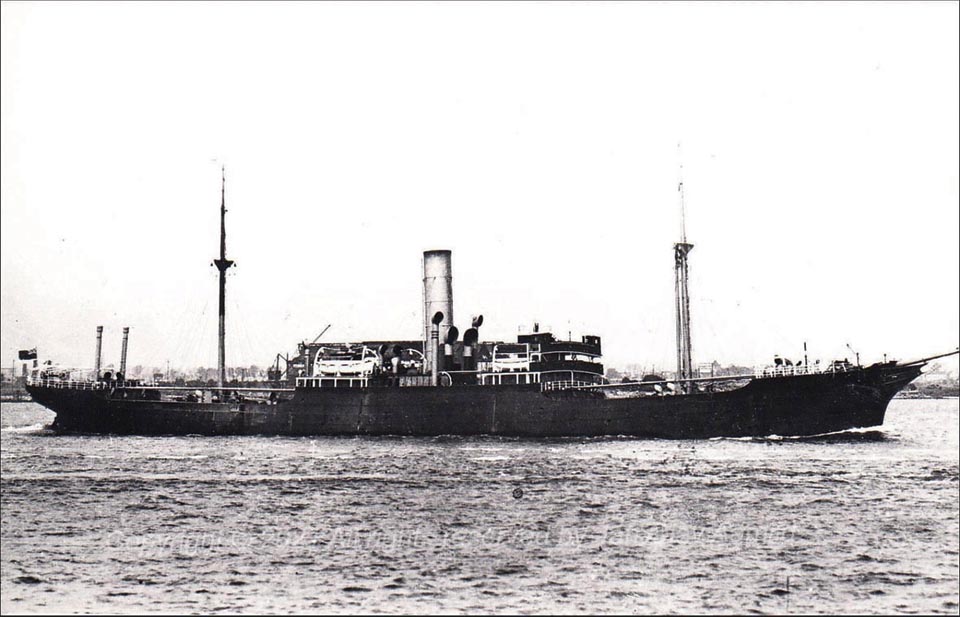

During World War I, many delays and problems occurred. This continued after the war as banknotes became more popular and the public demand grew. TdlR had problems printing in time and there were delays with shipments, which could be difficult to control, such as the dock strike in 1923. But overall it seemed like TdlR and the Siamese Government cooperated with each other very well. When Second Series was to be printed several printers were invited to submit bids. On December 1, 1923 Thomas de la Rue & Company Limited London won the bid.
References:
-Bank of Thailand Museum
-The archives of Thomas de la Rue & Company, Limited
-Bank of Thailand, “Centenary of Thai Banknotes: 1902 – 2002”
-Somchai Saeng-ngern, “Thai Banknotes Catalogue, Complete and Updated Edition”
-Banknote illustrations from Jan Olav Aamlid collection
Copyright © 2021 All rights reserved by Jan Olav Aamlid
 |
 |
 |





